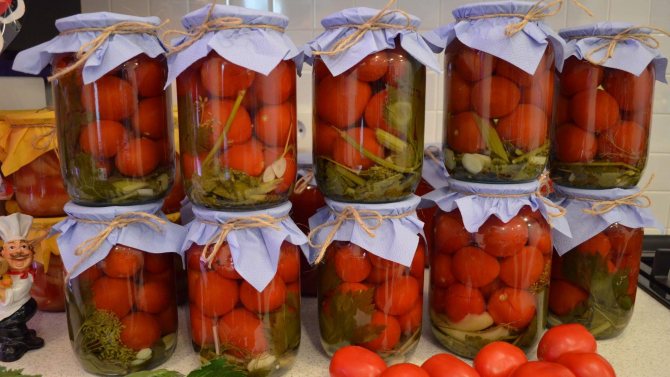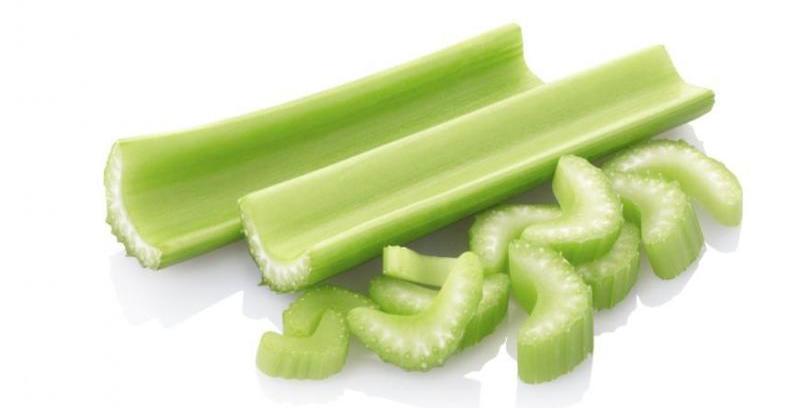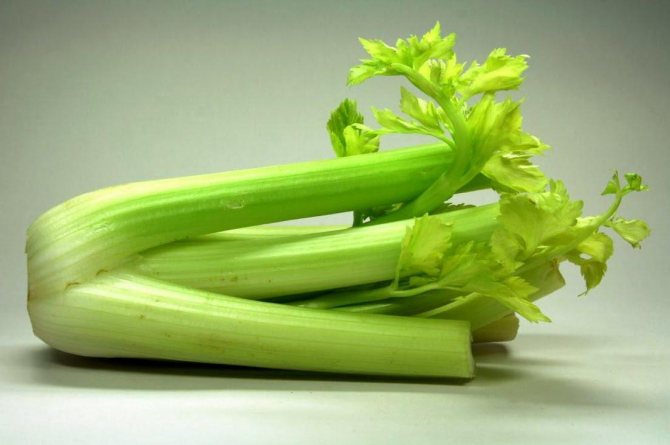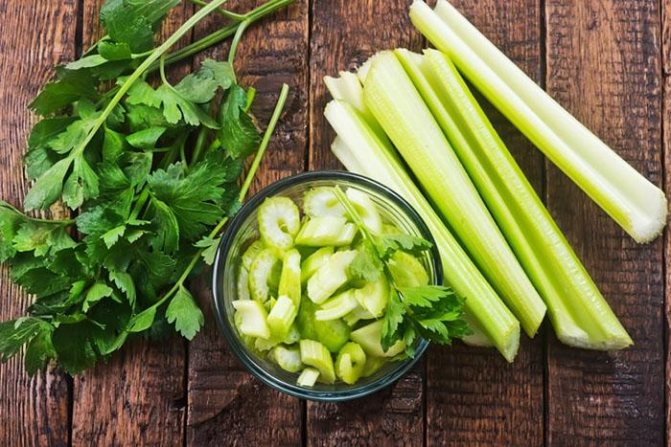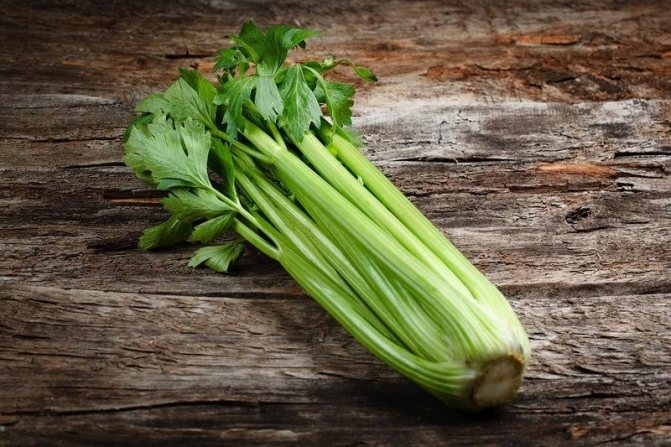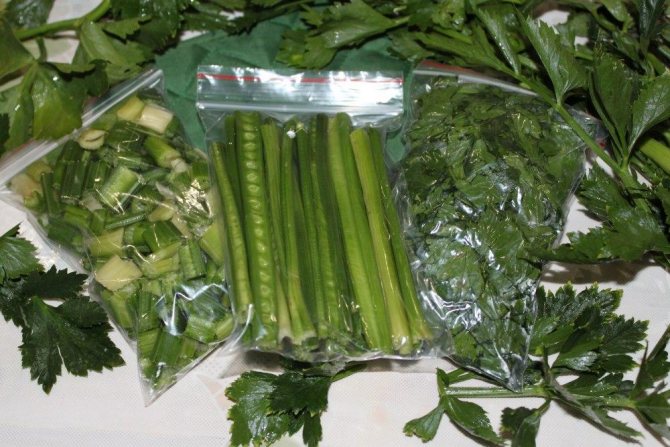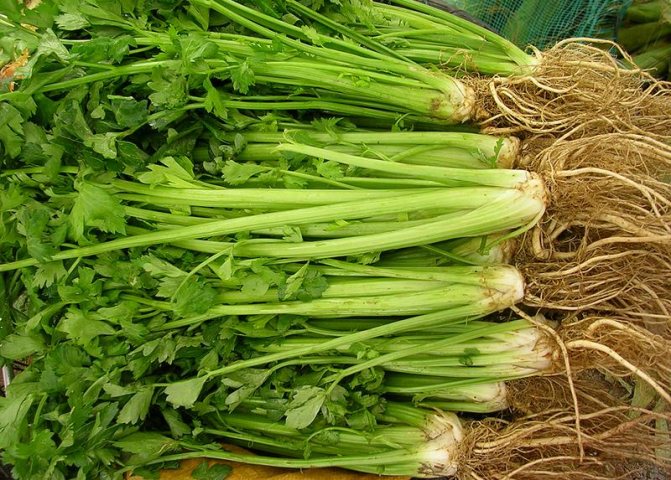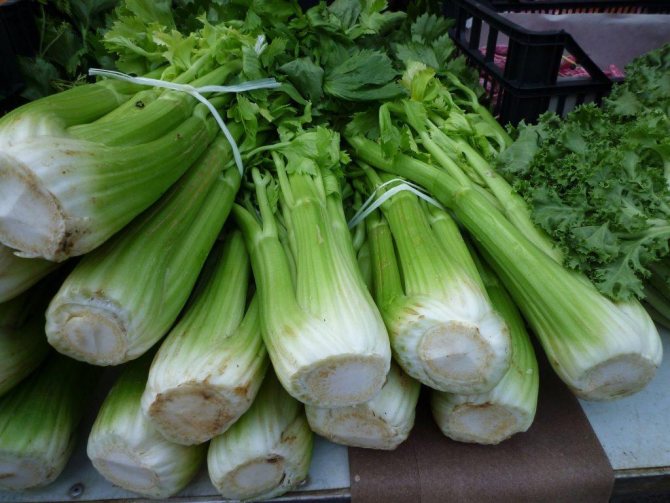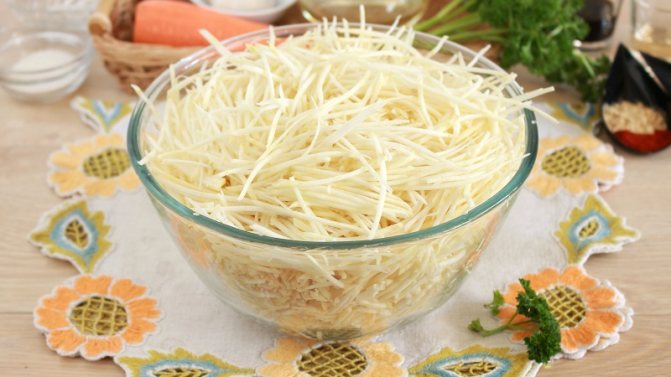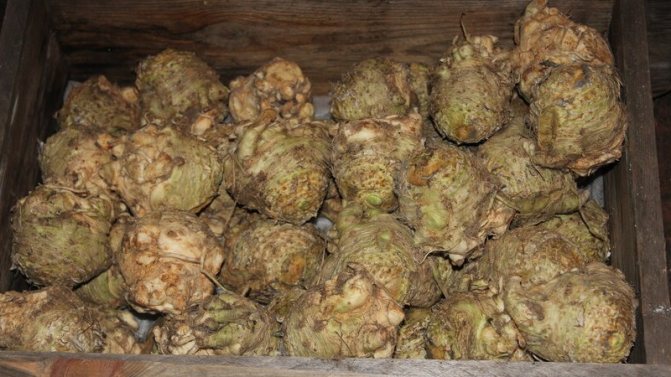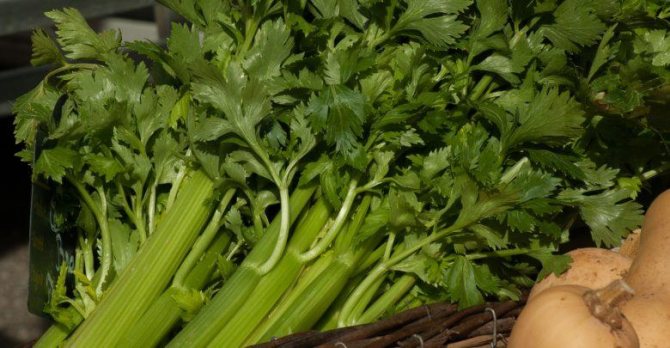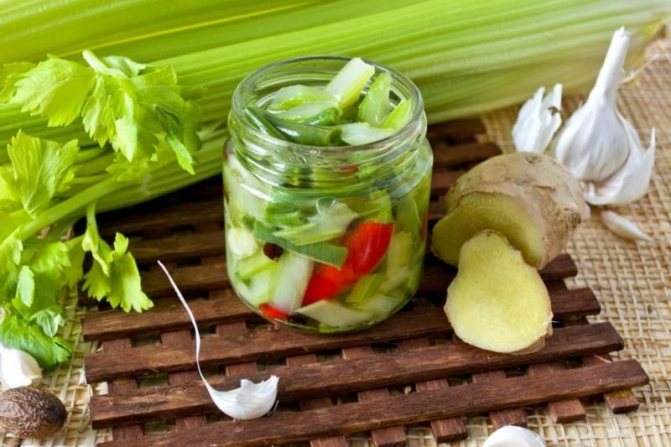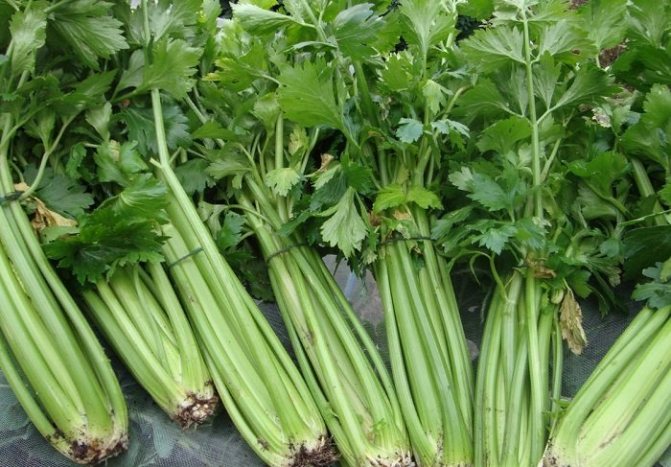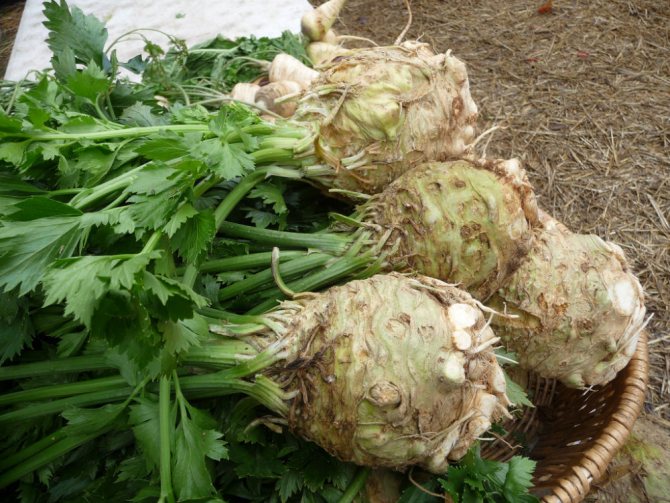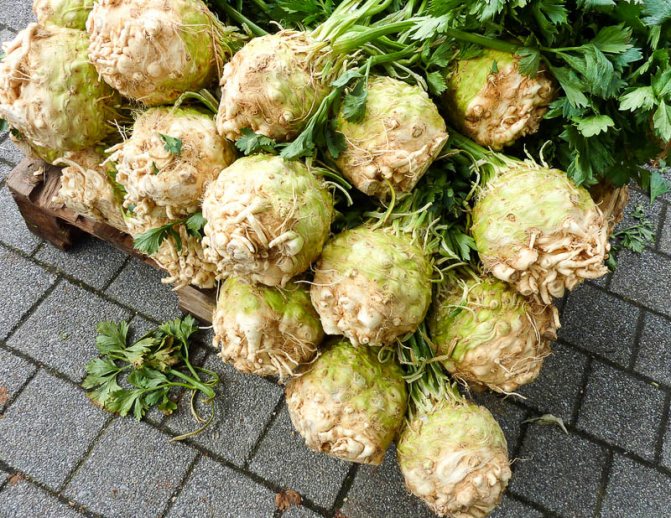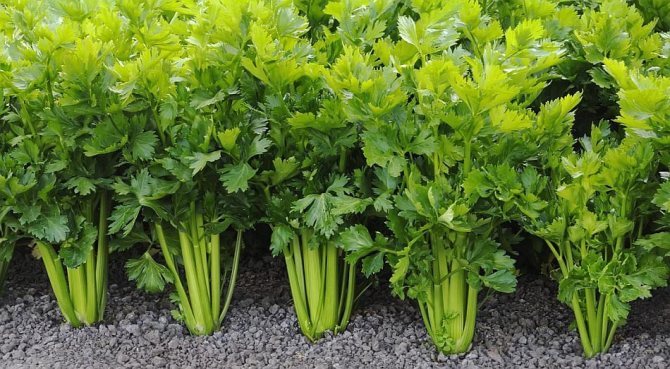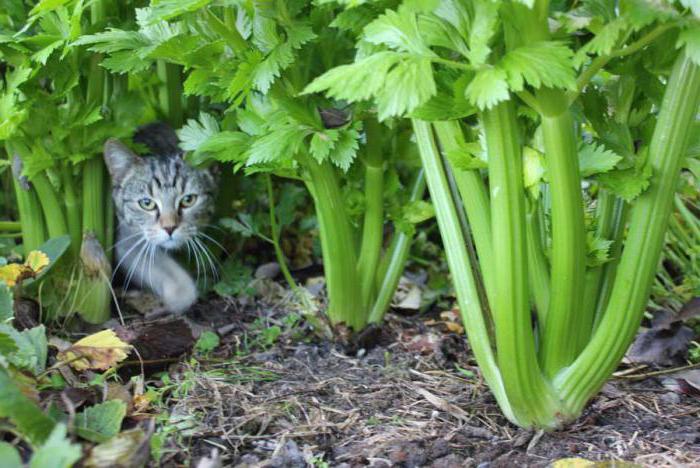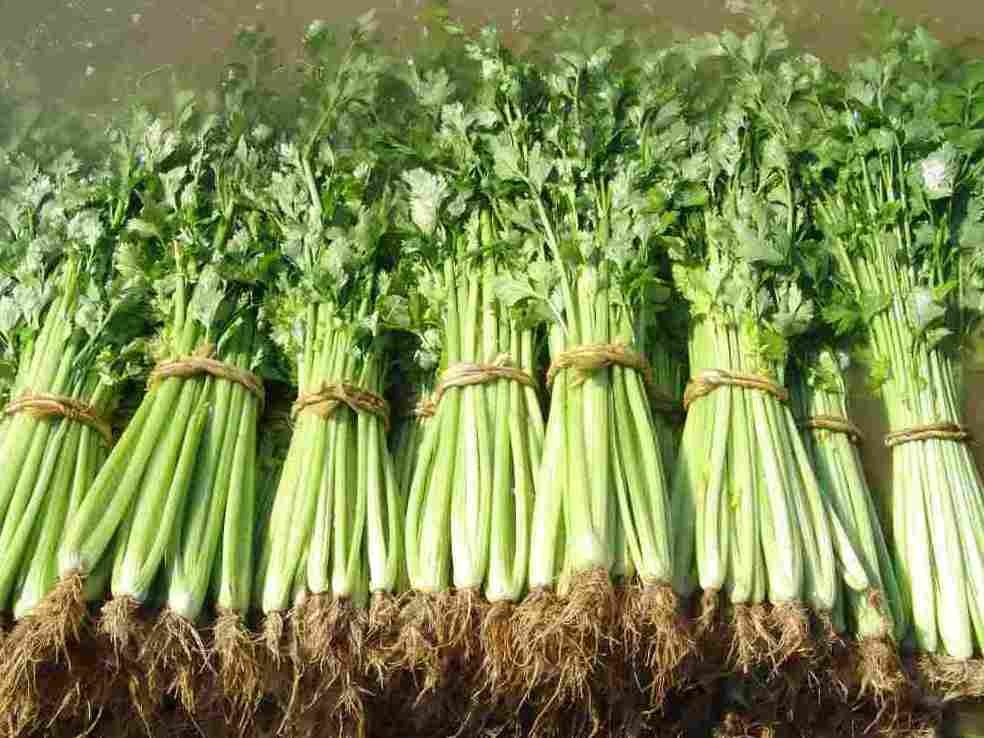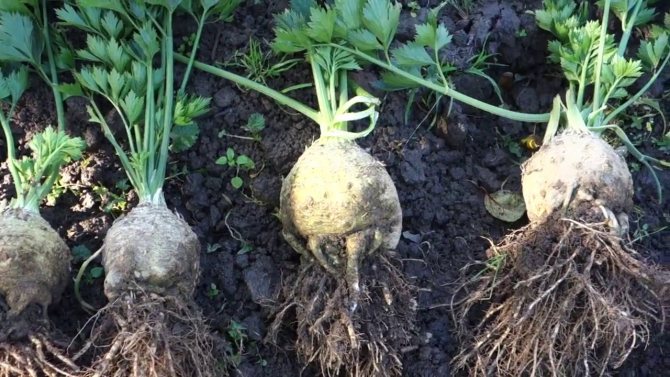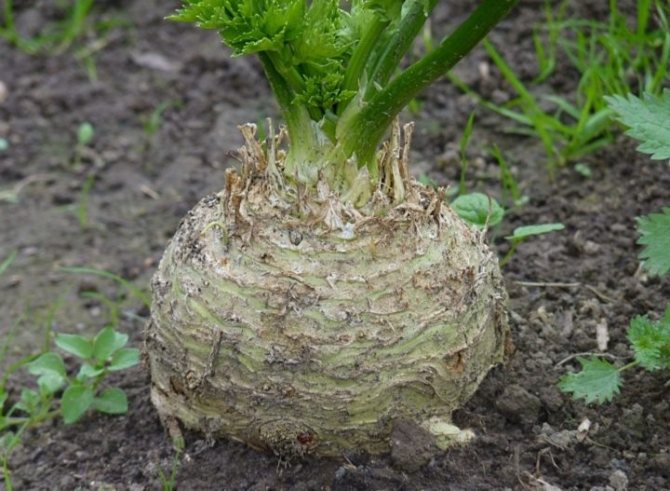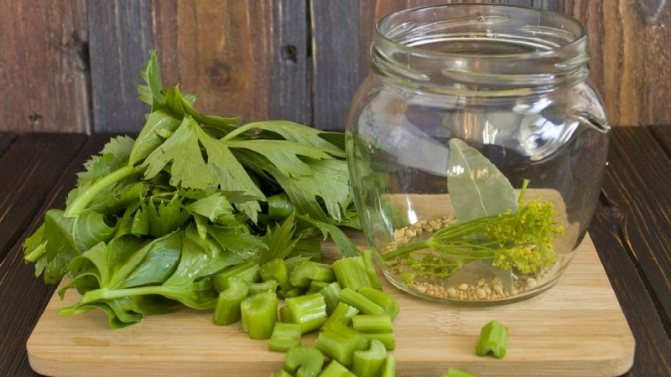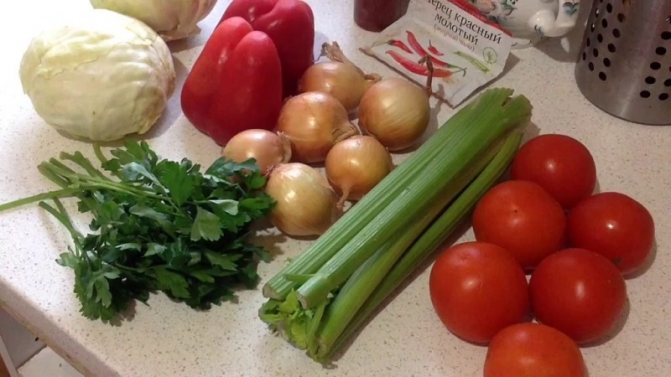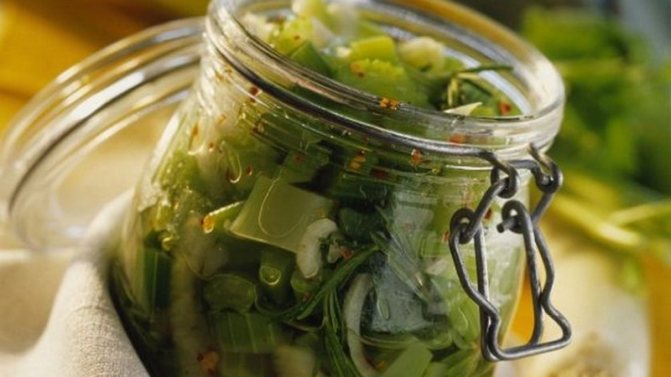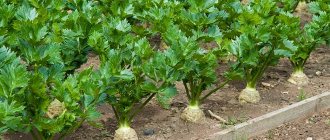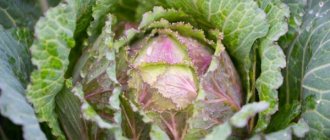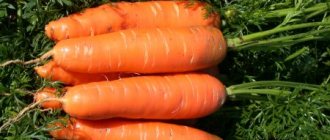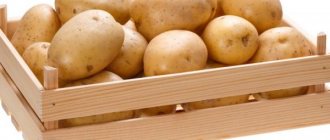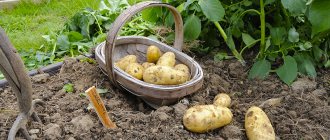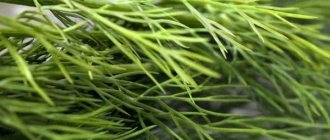Celery is a healthy, delicious vegetable that many people love. It contains many vitamins, micro and macro elements that help restore the protective functions of the body and calm the central nervous system. It is widely used in the culinary business for cooking meat, poultry, vegetable dishes, soups and various sauces.
It is impossible to find such a valuable product in winter, so the housewives have adapted to harvest it in jars for the winter. Not only leaves and petioles are used, but also the root itself. We bring to your attention a selection of the best recipes for harvesting celery for the winter.
Harvesting celery for the winter
This is the easiest recipe that requires almost no effort and will save you time. The products for the procurement use the most affordable.

Ingredients:
- a bunch of parsley;
- a bunch of dill;
- celery stalks;
- salt.
Preparation:
- Peel the stalk of the celery from coarse fibers. Cut into several pieces.
- Chop the dill and parsley finely. Mix with celery. Add salt.
- Divide the resulting mass into jars. Close the nylon cap.
- Store in the refrigerator.
Celery marinated with honey and butter
Products:
- celery stalks - 550 g;
- garlic - 1 head;
- a pinch of salt and ground red pepper;
- parsley - 70 g;
- sesame seeds - 1 tsp;
- anise - 1/2 part of the inflorescence;
- lemon juice - 55 ml;
- natural honey - 10 g;
- apple cider vinegar - 10 ml;
- olive oil - 10 ml.
Cooking process:
- Rinse the celery, remove coarse fibers and cut into 4-5 cm pieces. While the rest of the ingredients are being prepared, transfer the vegetable to a plastic bowl and close tightly.
- Peel the garlic cloves and chop into thin strips. Finely chop fresh, washed greens. Combine with celery, add salt, sesame seeds, anise, pre-chop it.
- In a deep bowl, combine lemon juice, beekeeping product, oil, acid and mix thoroughly. Spread vegetables tightly in sterile jars, pour marinade, close and put in a cold place.
Vegetable preparation with celery
Add seasonal vegetables to the flavorful plant and you have a great borscht dressing always on hand. You can also add the preparation to the side dishes.
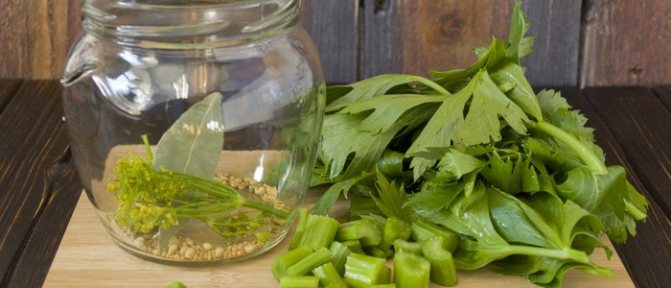

Ingredients:
- 500 gr. stalked celery;
- 1 kg. Luke;
- 1 kg. tomatoes;
- 1 kg. carrots;
- 300 gr. bell pepper;
- a bunch of greens - dill, parsley;
- 2 tbsp salt.
Preparation:
- Peel the celery stalks of coarse fibers. Chop finely.
- Grate the carrots. Cut the pepper into strips. Onions and tomatoes - cubed.
- Combine all vegetables. Add finely chopped greens. Salt. Stir.
- Divide into jars. Close the nylon cap. Store in the refrigerator.
Stalked celery for the winter
Celery improves digestion, has a beneficial effect on eyesight and rejuvenates the skin. Try to add as much of it to your diet as possible. And in order not to experience a shortage of it in winter, prepare it in brine.


Ingredients:
- 500 gr. celery stalks;
- 2 tbsp salt;
- 4 garlic cloves;
- 1 tbsp vinegar 9%;
- 2 tbsp Sahara;
- 2 bay leaves.
Preparation:
- Chop the celery finely. Arrange in jars.
- Add garlic cloves.
- Pour 2 liters of water into a saucepan. Add sugar, salt, add lavrushka.
- Boil, cook for 2-3 minutes.Add vinegar.
- Fill the jars with brine. Roll up the covers.
With garlic
The appetizer can be added to any meal. For a more gentle preservation, it is recommended to peel the stems by removing inedible and coarse fibers. Let's consider how you can make harvesting celery stalks for the winter.
- garlic - 70 g;
- celery stalks - 700 g;
- table vinegar - 25 ml;
- granulated sugar - 50 g;
- laurel - 3 leaves;
- filtered water - 2 l;
- table salt - 50 g.
Pour the required amount of liquid into a saucepan, add salt and cook until completely dissolved. Meanwhile, combine the acid with granulated sugar and put in salt water, stir.
Rinse the celery stalks, chop. Place peeled cloves of garlic, lavrushka on the bottom of sterile jars, and celery on top. Pour the prepared sweet and sour composition, cover and sterilize for a quarter of an hour. Carefully remove containers with contents, roll up tightly, turn over and cool.
Vegetable platter with celery
This vegetable mix has a very spicy aroma thanks to the celery. It can be used to complement hot dishes, garnish meat steaks or season soups.
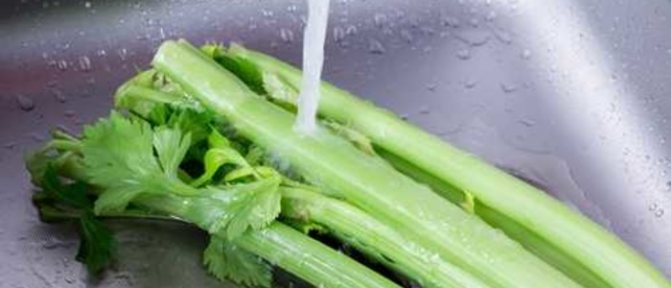

Ingredients:
- 1 kg. celery stalks;
- 1 kg. a tomato;
- 1 kg. zucchini;
- 300 gr. carrots;
- 2 tbsp salt;
- 2.5 tbsp Sahara;
- 100 g vegetable oil.
Preparation:
- Chop the celery finely.
- Grate the carrots on a coarse grater.
- Cut the tomatoes into half rings.
- Cut the peel from the zucchini, remove the seeds. Cut it into cubes.
- Mix all vegetables. Add salt and sugar. Pour in the oil.
- Cover the mixture and let sit for a couple of hours to let the juice stand out.
- Bring the mixture to a boil and simmer over medium heat for half an hour.
- Arrange in jars, roll up the lids.
Step by step process
Korean Pickled Celery Recipe:
- Clean and grate celery.
- Pour it into a bowl, pour in sunflower oil and add salt and sugar.
- Then sprinkle with seasonings.
- Pour in the vinegar and squeeze the garlic through the garlic.
- Mix our appetizer with our hand and set it aside in a cool place for a couple of hours.
As you can see for yourself, pickling celery is very easy. Thanks to the variety of recipes, each of you will be able to find something suitable for yourself.
Pickled celery
The fragrant plant can also be pickled. In this case, you can serve it to the table as an independent dish, and supplement with boiled potatoes or rice.


Ingredients:
- 2 stalks of celery;
- 5 cloves;
- 5 pieces. allspice;
- 2 tbsp salt;
- 1/2 tsp citric acid.
Preparation:
- Chop the celery finely. Pour 0.5 liters of water. Add citric acid and bring to a boil.
- After boiling, cook for 3 minutes.
- Divide the celery into the jars. Spread the spices as well.
- Fill the contents with brine. Roll up the covers.
Celery will diversify your usual preparations for the winter. Marinate it or make a soup dressing that you can get out of the fridge at any time.
Celery is a healthy vegetable that doctors and nutritionists recommend adding to your diet as often as possible. Especially in winter, when the body lacks vitamins. But it is not so easy to buy it in the cold season. Therefore, it is important to know how to preserve celery for the winter at home.
The uniqueness of this vegetable is that you can eat both leaf and petiole and root parts. And then, and another, and the third contains a large number of useful trace elements for the body. To enjoy dishes with this vegetable, you need to know when to remove celery and how to store it so that it does not lose its beneficial properties.
Harvesting celery for the winter is not too troublesome. Basically, the following storage methods are used:
- drying;
- freezing;
- salting or pickling.
Which one to choose is up to you. Let's consider each method to make it easier for you to make the right choice.
The best time to harvest
The harvest carried out on time guarantees that it will lie for a long time and at the same time will not lose its aroma and nutrients. When to harvest and how to preserve root celery? Let's figure it out in order.
Do not rush to remove the vegetable from the garden. The longer it stays in the ground, the better. This allows the root to acquire the following qualities:
- grow in size and mature;
- become covered with a hard, elastic skin.
The question of when to remove celery is very important. A mature root crop is ready for transportation, storage, it is not afraid of damage, spoilage, decay.
The timing of when to dig out is individual, depending on the type of plant and the climatic conditions of the region. On the one hand, you have to wait until the root crop is fully ripe. On the other hand, cleaning during the first frost is unacceptable, because frozen specimens will quickly deteriorate.


Practitioners advise about a month before the expected harvest to cut off the shoots of celery, the lower leaves, so that it ripens further without them.
Collection and fresh storage
Before preparing celery for the winter, it must be collected in a timely manner and correctly.
Around late July or early August, celery ripens and is time to harvest. If you do not catch this moment and wait for the flowering of the plant, you can no longer touch its leaves - they lose their beneficial properties.
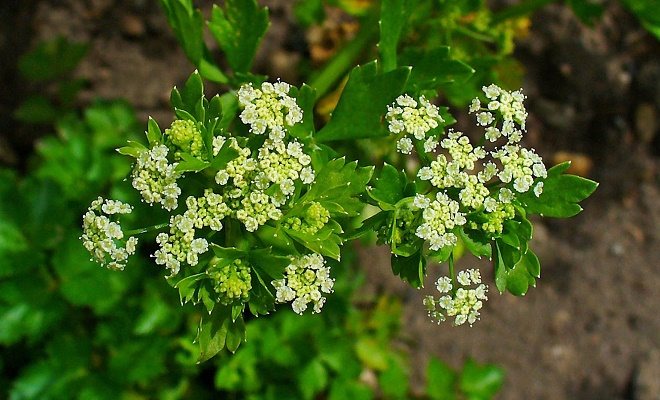

Fresh vegetables can be eaten for 3-4 days if stored at room temperature. In the refrigerator, this period can be extended to two weeks, and in maturing varieties - up to a month. The dead ones include:
- "Tango" - petioled, mid-season, high-yielding and very aromatic;
- "Parus" is leafy, mid-season, high-yielding, resistant to flowering and very tasty.
You can try to keep the celery fresh for longer. But this must be done in the basement or in the cellar, where the temperature is kept around 0 ° C. In this case, you need the celery along with the root. After harvesting, place the stems in a box of wet sand, sprinkle the roots, and store them in the cellar. Check the condition of the plants periodically by removing rotten or dried out specimens. [flat_ab>
To get a white, delicate stem from celery and improve its taste, it must be "bleached", that is, protected from sunlight. To do this, 20-30 days before harvesting, wrap the stems with opaque material. Cloth, paper, cardboard and even plastic bottles will do, as in the photo below.


Basic storage methods
Several options are known for storing the product at home. The most common are:
- drying;
- freezing.
The technology of each type assumes the preservation of the vegetable for a certain period. The simplest methods make it possible to store greens for three weeks, subject to compliance. Long-term storage assumes special conditions, temperature conditions and preparation process.


The deciduous part of celery withers quickly. To make the use of a dried or frozen product as pleasant as possible, hurry up to process it. Leaves should be trimmed and rinsed as quickly as possible. Then dry on a paper towel. After drying, it is recommended to wrap the raw material in foil. Do not replace foil with polyethylene or plastic. These substances act as wilting catalysts.
There is an interesting option to keep the leaf celery for the winter, even fresh. To do this, you will need a specially designated place in the cellar, covered with sand. During harvesting, you need to dig out the bushes with roots, transfer them to the basement and place them in the sand. If there is no cold room in the house, aluminum foil and a separate space in the refrigerator are enough.
Drying
This is one of the best ways you can preserve the benefits of leaf celery and provide seven vitamins throughout the winter.There are several ways to prepare dried celery. The first option is natural drying. The deciduous part is knitted in bunches and hung in a spacious room where air circulates freely. The second involves the use of a lamp or other light source. The raw materials should not be exposed to sunlight. To do this, the laid out leaves are covered with parchment on top. Thus, you can protect them from the negative effects of the sun, and at the same time dry well.
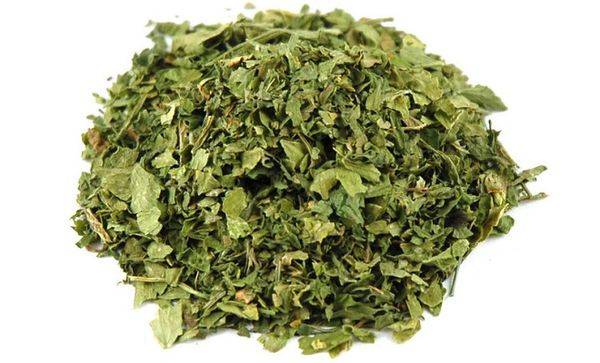

It is recommended to grind the finished product into powder using a blender, mortar or by hand. In a month, you will be able not only to dry the leaves, but to preserve their natural aroma and piquancy. Seasoning made from leaves and stems is also very popular. It can be stored in a pouch or glass container.
Shop selection rules
If you don't have a vegetable garden to grow a healthy vegetable, you can buy one at the market or store. In order to purchase a high-quality and useful product, some features should be taken into account when choosing:
- To make sure the celery is fresh, lightly press down on the stem with your finger - it should be firm and not squeeze.
- The freshness of the leaves is also determined by the firmness and smoothness of the stems.
- Tap the stem lightly before purchasing. If it is empty, a characteristic sound will be heard - such plants are not suitable for food.
Freezing features
Before you figure out how to freeze celery, you need to understand that as a result, it will lose its integrity and structure. Therefore, in the future it can only be used in sauces, broths, soups and for making aspic. But at the same time, it will retain all its properties and remain useful until spring.
To freeze celery, you need to prepare special hermetically sealed bags or plastic containers. Ordinary pouches can be used, but in this case it is difficult to avoid getting air inside.
Further actions are performed in several stages:
- Separate the leaves from the stems, rinse thoroughly and place on a dry napkin. To speed up the drying process, you can also blot the top with a dry towel.
- Chop the leaves not too finely so they don't turn into mush. They should be the same size as for a regular summer salad.
- Divide the slices into bags or containers and place in the freezer.
Make sure that the greens are completely dry, otherwise, when frozen, the moisture will turn into ice, and the leaves will stick together into one mass. It is important to keep the freezer bag or plastic container tightly closed as celery has a strong odor.
It is better to immediately pack the blanks into small bags, so that you can then use one of them at a time. It will be more difficult to separate the frozen product with a whole briquette.
You can also freeze celery for the winter:
- In the form of a smoothie, grind the cuttings and leaves with a food processor or blender and put them in small containers. This preparation will be an excellent addition to puree soup.
- In an ice mold filling with water cut with a knife greens. Get Vitamin Cubes that are easy to use in soups and gravies.
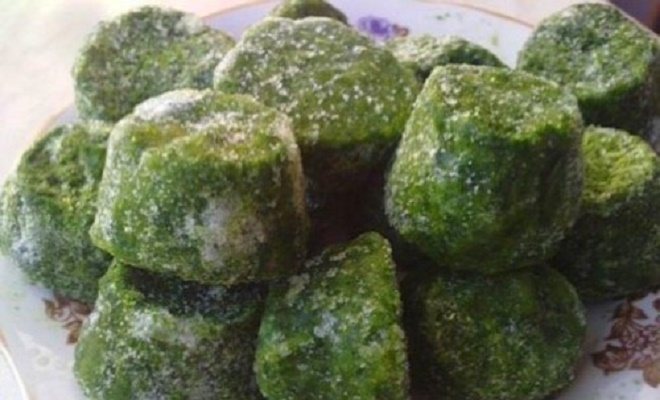

In addition to the leaves, you can freeze celery stalks in the same way. The principle of their preparation for storage also includes cutting, washing and packing into bags.
Long-term storage options for celery roots
After the root crop is dug out of the ground, brought from the market for its subsequent harvesting, you should check whether there is rot or not - this procedure should be carried out throughout the entire process of storing it in winter.
To do this, it is enough to press on the root vegetable - the pulp of a healthy, undamaged plant will remain in place, if the root vegetable is spoiled - its internal structure will be soft to the touch, and from above it is covered with mucus.
To preserve the root crop of celery throughout the winter period, it is quite often in practice that experienced gardeners - gardeners use the method of storing it in an upright position in the sand.
To do this, it is worth filling the wooden container with dry sand and placing the roots in it in an upright position so that the top, the stalk is on the surface.
Such a container with sand and root crops is stored in a cellar or basement, where the storage temperature is no more than 1-3 degrees Celsius.
You can also save the roots of the plant for a long time with the help of clay - in this case, it is enough to prepare a liquid solution of clay, bringing it to the consistency of liquid sour cream and dip each root separately in such a solution.
After drying them in the sun, placing them on the street and after drying, you can stack such a workpiece in a cellar or basement.
In fresh form, the root crop of the plant itself can be stored until spring and in an impromptu earthen embankment - it is enough to place the root in layers, laying them in a row, sprinkle it with earth with the addition of chalk from bacteria and mold and lay the next level on top.
With this method of storage, it is worth remembering that the top of the root crop should not sink into the ground, remaining free outside.
The rhizome of a plant can be perfectly harvested by cooking and keeping it dry - it is enough to rinse it thoroughly, peel it and cut it into thin strips and dry it in the sun, then store it in a tightly closed glass container.
Alternatively, you can interpret this recipe - also peel the plant, grate the root vegetable and put it in bags and send it straight to the freezer.
You can also fully, and most importantly, store the root crop for a long time simply by digging out the rhizome with an earth lump and in this form put in wooden boxes and store in a dark cool place - a cellar or basement.
Drying natural and accelerated
Drying is another way to preserve celery. Like freezing, it helps to preserve all the beneficial properties and qualities of the vegetable. Moreover, you can dry both leaves or stems, and root crops.
In order to properly prepare celery greens, to preserve its benefits, you need to remember several features of this process:
- Leaves and petioles can be dried either chopped or whole.
- Place the herbs in a thin layer on a lined baking sheet or tray.
- Dry, occasionally turning, at room temperature in a ventilated area or under a canopy outdoors.
- After drying, fold the seasoning into an airtight container, place in a shaded dry place. Whole twigs can be chopped or stored as they are.
Even completely dry celery does not change its color, smell and taste for up to 2 years.
Take your time and let the plants dry well, then the storage of celery will be long: it will not mold and rot.
You can speed up the drying process using an oven, microwave or electric dryer. The temperature should be around 40 ° C.
If you harvest the petioles and leaves at the same time, then you need to take into account that the leaves dry out quickly, but the petioles remain wet for some time. Separate the leaves from the cuttings (it is very easy to do this when dry), and dry the cuttings.
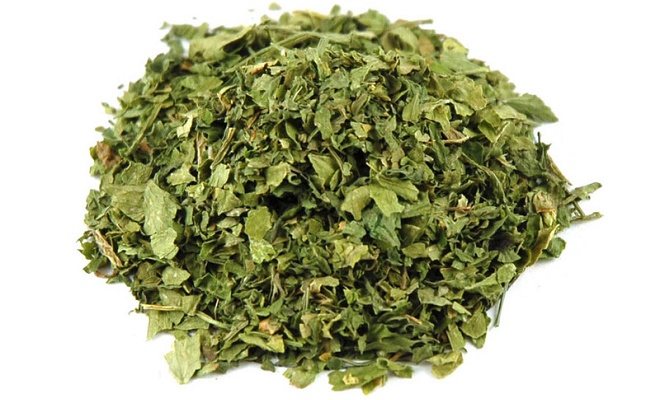

Celery roots can be dried in the same way. They also contain many useful substances, and the range of culinary dishes using them is very diverse.
Tips from experienced housewives
Experienced housewives know the secrets of making celery:
- In all the recipes described, celery greens are successfully replaced with petioles or root. In this case, the blanks will have completely different tastes. A mix of several parts of celery turns out to be unusual.
- During the summer, you can freeze all the greens left over from cooking in oil or water.
- Rough celery stalks do not need to be thrown away.Tie them together and dry them for a delicious broth seasoning. The bunch is placed in boiling water, and at the end of cooking it is removed and discarded.
Salting and pickling
In addition to drying and freezing, you can save celery leaves or stalks for the winter by salting. It will not lose its properties for a long time, and in winter you can add it to many dishes.
The process of salting celery is as simple as the other operations:
- Prepare a three-liter jar or container that you can seal tightly. For 1 kg of celery, take 200-250 g of salt.
- Before salting, wash the leaves or stalks of the vegetable, remove all yellowed parts, and finely chop.
- Toss the herbs and salt in a large bowl, then place them tightly in the prepared container, leaving room for the juice.
Close the salted container well to restrict air access. If you use a nylon lid, keep the jar in the refrigerator. If you decide to roll it up under a tin can, you can store it in the pantry or in the cellar.
Salting is used less often than freezing or drying. In addition, in the future, when using celery, you need to take into account that it is already salty. This means that you need to add salt to dishes much less.
Celery can also be pickled (it will be stored for up to 2 years at a temperature of 4-6 ° C). There are many recipes for how to do this. One of them is exquisite, from the chef - watch in a short video:
By following all the recommendations on how to properly store celery, you will be able to make preparations for the winter and add a healthy and tasty product to your food throughout the cold season.
Preparing celery for storage does not take long and does not require much effort. But in winter, when the body lacks vitamins, it will become an irreplaceable source of energy for you.
The herbaceous plant of the umbrella family, thanks to a whole range of useful substances and a particularly pronounced spicy taste, occupies a leading position in the field of cosmetology and pharmaceuticals, as well as in cooking. That is why harvesting celery for the winter allows lovers of this piquant and vitamin herb to enjoy it all year round, both as a universal additive to certain vegetable dishes, and as a seasoning for various meat dishes.
Selection and quality control
When the crop is harvested, they begin to check the quality and sort the root crops. Pick the best samples that will easily retain their aroma and flavor until spring.
Signs of a quality product:
- the color of the peel should be uniform, without spots, knots and yellowness;
- the top should not be loose, soft; if you come across such a root, fold it back - it is not suitable for storage and will soon begin to rot;
- when pressed, the pulp should be elastic, firm, and not sluggish, soft;
- the sound when tapped should be sonorous; if he is deaf, then there are voids inside.
After the selection of root celery for the winter, you can start laying it for storage. If you haven't cut the tops before, do it now. Cut the leaves with cuttings at an angle, let it remain about 2-3 cm.
Be careful not to hit the apical bud during the pruning process. Without it, the vegetable will quickly deteriorate.
The benefits of celery
Literally 9 centuries ago, this fragrant herb, whose relatives are carrots, cilantro, parsley, was used only for the preparation of medicinal decoctions and preparations, but now the product is widely used in the field of cooking.
In addition, any part of celery is literally saturated with useful substances in the form of:
- all kinds of amino acids;
- essential oils;
- a whole range of vitamins.
The mineral component of the herb is phosphorus, magnesium, calcium, sodium, iron. And 100 grams of green celery stalks contains only 13 calories, while the root of the plant contains 42.
With the constant use of celery:
- pressure decreases;
- the immune system is strengthened;
- toxins and slags are removed;
- the state of the nervous system is normalized;
- metabolic processes are improved.
In addition, herbaceous culture prevents excessive gas formation in the intestinal tract, promotes the production of gastric juice and normalizes the body's water-salt balance.
Regular consumption of vegetables by representatives of a strong half of humanity leads to a clear increase in their potency.
Also, acting as a strong antioxidant, celery prevents cell withering in older people.
And essential oils also present in the culture:
- have a positive effect on the skin;
- improve appetite;
- participate in the restoration of vision.
Useful and harmful properties
Fresh stems contain a lot of nutrients, so this product has a beneficial effect on the human body. The plant has a rich composition - its leaves contain vitamins A, B1, B2, B3, B5, B6, C, E, K, valuable amino acids, essential oils and trace elements, as well as fiber.
Did you know? Celery is a “negative calorie” food - the body spends more calories on its digestion than it receives in return.
- Celery has the following beneficial properties:
- slows down the aging process in the body;
- relieves overwork and helps fight stress;
- improves digestion;
- contributes to the normalization of water-salt metabolism;
- eliminates headache;
- lowers blood sugar levels in diabetics;
- has a beneficial effect on the work of the heart;
- reduces joint pain and relieves swelling;
- increases the overall tone of the body;
- promotes wound healing;
- stimulates the brain;
- removes toxins from the body, cleanses the blood;
- strengthens the immune system;
- helps to cope with diseases of the genitourinary system;
- enhances libido;
- helps to effectively fight excess weight.
Despite the long list of beneficial properties, when using the plant, you must comply with the norm, since in large quantities it can be harmful to the body.
- This product is contraindicated in such cases:
- hypotension - the leaves and root of the plant lower the level of blood pressure, which causes a deterioration in well-being;
- the presence of allergies - the stem contains substances that can cause an allergic rash;
- acute diseases of the digestive system (ulcer, gastritis) - by stimulating the production of gastric juice, the product increases pain in the stomach and intestines;
- the last trimester of pregnancy - the stems of the plant can cause food allergies in the baby;
- uterine bleeding - the product stimulates blood circulation, so it can aggravate the situation;
- women during lactation - the constituent elements of celery pass into breast milk, change its taste and smell, and can also cause allergies in the child;
- urolithiasis - the product has a strong diuretic effect on the body, which can provoke the movement of large stones.
Important! The daily intake of celery for a healthy adult is 160-200 g.
Petiolate and leafy celery, differences
The umbrella plant, which attracts the eyes of numerous culinary experts due to its spicy aroma and unforgettable taste, is served both raw, for example, in salads, and as various additions to certain dishes. Moreover, in cooking, according to one or another recipe, all available plant fragments are used. Allocate: root, petiole and leaf types of celery. The root variety is a fleshy root widely used in cooking.
The petiolate variety, being a two-year-old plant, produces a rosette of green leaves and a root from which the petioles grow.In the first year of celery life, the greens of the plant are cut, the next season the seeds are used.
The dense stem of the culture is studded with forming leaves of a pale green color. The petioles themselves grow from the root of the vegetable culture. Small whitish inflorescences that form by the end of August begin to gather in umbrellas. When they ripen, the so-called boxes appear on the plant, in which the seeds are located.
Important! To prevent the appearance of a certain bitterness at the petioles of this plant, celery bushes should be hilled from time to time.
The stem type of the plant is literally saturated with vitamins and essential oils. That is why the use of this variety in preservation - in pickled, frozen and dried form, as well as in salads, mixed, for example, with carrots and dill, in the form of an additive to soups and main courses - helps to replenish the lack of nutrients and vitamins in the body in winter. of the year.
The leafy type of grass is planted in summer cottages and household plots to obtain greenery throughout the summer season. And despite the fact that this variety is not supplied with root crops and petioles, its greenery pleases gardeners even in the autumn. The leaves of this type of celery contain much more nutrients than those of its relatives. Use the leafy herb as a seasoning for salads and baked goods.
When to harvest all types of celery
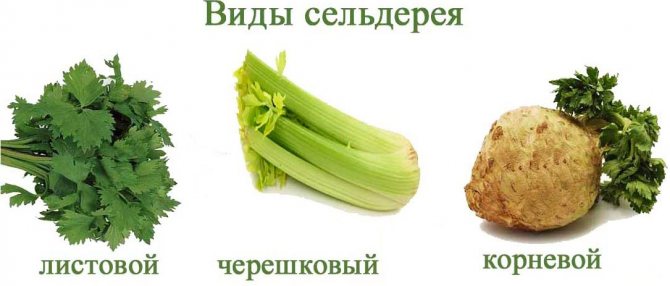

Root and petiole varieties of celery are often canned. There are three types of celery: root, leaf and petiole. Growing a useful culture in your own beds is half the battle. It is important to choose the right way to store it in order to preserve the healthy qualities of the vegetable as long as possible.
Root


In autumn, the root of the vegetable increases its mass, and also gains all its main beneficial properties.
This type of celery can be in the soil almost until the first snowfall, but the tubers cannot be frozen. If the root crop is touched by frost, this will negatively affect the taste of the vegetable, as well as the shelf life.
But it is also not worth digging up tubers ahead of time, since the concentration of nutrients in them reaches a maximum just by the arrival of the first snow. Therefore, the harvesting of the root crop falls around mid-October. However, gardeners should, of course, follow the weather forecast so as not to ruin the harvest.
Sheet


The celery must be harvested before the peduncles appear. Otherwise, it acquires bitterness and uncharacteristic aroma.
The collection of the leaves of this vegetable must occur before the onset of frost, otherwise all the valuable components of the plant will be lost. The latest time when you can cut its leaves is the end of September. By this time, the concentration of vitamins and trace elements in the greens of the vegetable will be maximum.
Petiolate
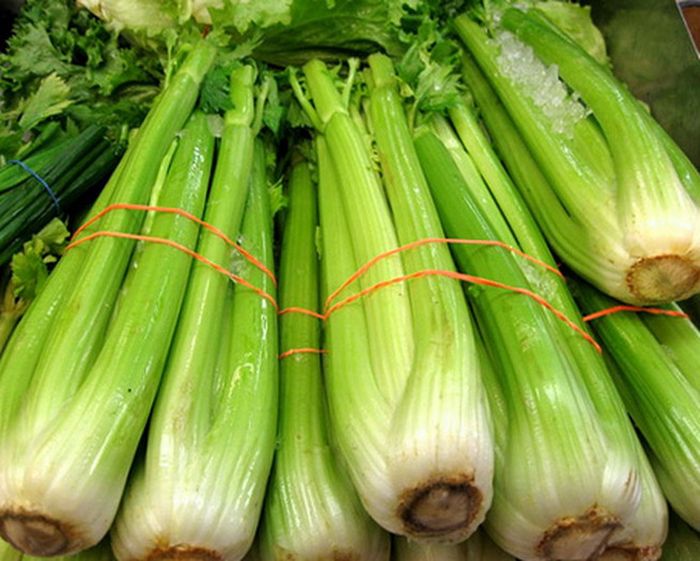

When you need to harvest in the summer, preference is given to early varieties - leafy Golden Malachite, petioled - Parus, root Diamond or Apple
This type of crop is also sensitive to low temperatures, so you need to cut the petioles before the first frost. As a rule, the harvest takes place in September. But if the celery was grown by the trench method and there is an opportunity to shelter the stems from the cold, then the petioles are harvested 3-4 weeks later.
Experienced gardeners are strongly advised to bleach a rosette of stems a couple of weeks before harvest. To do this, you need to collect the petioles in a bunch, then wrap their lower part with paper, burlap or other material that will not allow light to pass through, but will allow the plant to breathe. Thanks to this procedure, the petioles lose their bitterness and become more tender.
Preparing the main ingredients
The petiolate type of celery begins to be harvested closer to autumn. During this period, the stems contain the greatest amount of juice with useful substances and microelements.The root variety, which is not afraid of frost, is carefully removed from the ground with a pitchfork and descends into the cellar for storage.
In the stem variety of grass, ripe and cut petioles are washed, damaged parts removed, and dried. The petiole ingredient packaged in a bag keeps well in the refrigerator. The stalks prepared in this way are used throughout the winter to prepare all kinds of dishes.
Leaf culture, after collection, is laid out in bunches in places without access to the sun. Parchment is placed on top of the grass, for better drying of the plant, which lasts about a month. After the celery is chopped and further stored in a glass container.
Celery blank recipes
It is rare when in winter you can find celery in supermarkets - a fragrant and piquant herb with a unique composition. But real hostesses have learned how to independently harvest celery leaves, petioles and root fruits for the winter at home, in their usual conditions, while preserving essential oils, amino acids and vitamins in the product, which are so necessary for the human body.
A simple recipe will not only allow you to preserve the vitamins available in the vegetable culture, but also prepare the seasoning quickly, without any difficulties.
- dill - a bunch;
- celery - a bunch;
- parsley - a bunch;
- salt.
Method of preparation: sort out the washed greens, remove dry and spoiled stems. Then finely chop each bunch with a knife, mix between themselves and grind with salt. Arrange the workpiece prepared in this way in glass jars under the lids.
Lovers of delicious food and not just enjoying food, but in order to get enough vitamins for the winter, prepare a wide variety of vegetables, for example, to create a dressing in borscht or in any other soup.
- carrots - 1 kilogram;
- tomatoes - 1 kilogram;
- onion (turnip) - 1 kilogram;
- celery - a bunch;
- dill, parsley - in a bunch;
- pepper - 350 grams.
Method of preparation: grass and tomatoes, previously washed and dried, must be chopped. Chop the remaining vegetable set.
Important! The workpiece prepared in this way requires thorough mixing with salt. Arrange the vegetable mass in jars and send to the refrigerator.
How to keep fresh
Parts of the harvested culture will not lose their useful qualities if they are stored in polyethylene laid in the refrigerator. For longer storage, fresh grass is placed in sandy soil, somewhere in the cellar, packaged in cellophane bags. The vegetable can be sent to a cellar with significant humidity and a temperature of one degree. Also, the tubers will last until spring, laid out in rows in the cellar.
For stalked and other types of celery, there are other storage methods:
- green plant fragments are salted, set aside for a few days for infusion, packaged in glass containers and rolled up;
- the whole plant or parts of it are frozen, special ice molds are used for this. In this form, celery retains not only a spicy aroma, but also the available vitamins and amino acids;
- culture leaves are packed in plastic molds and frozen in a refrigerator.
Important! The grass, laid in foil, retains its original appearance for about 10 days. In the film, celery begins to fade already on the third day.
And, for example, a culture taken from the ground along with the root system and dug into the sand somewhere in the basement will remain until spring.
Drying
The leaves of this culture will not lose the main amount of essential oils, amino acids and various microelements when using the preparation methods presented below.The leafy part of the plant is taken away from the stems, tied in bunches, dried, and then suspended from the wall in a well-ventilated room, inaccessible to the direct rays of the sun.
Also, celery leaves, when placed on any surface, are covered with paper on top. Naturally, the drying time itself increases, but the beneficial properties of the fragrant herb are not lost. The foliage dried in this way is laid out in containers.
Freezing
Due to the fact that the fragrant plant is literally stuffed with the most unique components, its use in winter is so popular. Freezing is one of the easiest ways to preserve a plant. Celery, or rather its leaves, are carefully laid out in molds, and then parts of the plant are immersed in water. You can also freeze the petioles, packaged in containers and filled with liquid.
Although true gourmets and experts in their field know that such a way of freezing celery can lead to a partial loss of its properties.
Dry salting method
In order for the vegetable crop to look as if it had just been plucked from the garden, a special cooking method is used. Thoroughly washed, dried celery leaves are mixed with non-iodized salt and placed in a glass container. The green mass is lightly rammed, and after the formation of juice, it is sealed with lids and removed to some basement.
The dry salting method gives the preparation a special salty taste, which can be combined with any spices for salads, soups and main courses.
Pickled root and petioles
As mentioned above, the leaf part and stems of the plant are subjected not only to drying, but also to freezing. This appetizing dish in the form of a pickled root goes well with meat, fish, and potato dishes, and retains all the useful qualities of the vegetable.
Greenery harvesting options
The most effective ways to preserve celery leaves are considered to be the following:
- Dried... Separate the green leaves from the stems. Tie into small bundles and place in a well-ventilated, dark place. The second option is to spread the leaves on a newspaper in a thin layer and wait until they dry completely. Drying time - 30 days. After grind the fragrant herb into a powder, place it in a glass container for storage;
- Freezing Is the most popular way to preserve fresh, aromatic greens. Rinse the leaves, dry and chop finely. Put in prepared disposable bags or containers, put in the freezer.
There are 3 ways to preserve vitamins and nutrients in spicy greens - dry ambassador... Let's look at step-by-step instructions on how to prepare leafy celery for the winter.
Products:
- dill - 100 g;
- parsley - 100 g;
- celery - 100 g;
- rock salt - 200 g.
Rinse the greens, put them on a dry towel and dry. Chop finely, pour into a convenient bowl. Add table salt and mix thoroughly. Cover and leave on the kitchen counter for half an hour.
After the time has elapsed, spread out in sterile jars, close hermetically and put away in a cold place. The aromatic seasoning will perfectly complement any dish, saturate it with useful substances.
Leaf celery soup mix
Products:
- turnip onions - 500 g;
- carrots - 500 g;
- sweet peppers - 500 g;
- celery - 200 g;
- juicy tomatoes - 500 g;
- parsley - 30 g;
- dill - 30 g;
- table salt - 30 g.
Peel the carrots, chop into thin strips. Remove the stalk and seed box from the capsicum and cut into strips. Do the same with onions. Rinse the tomatoes, cut into 2 parts, chop into cubes. Rinse fresh herbs, chop finely.
Combine prepared vegetables in a large saucepan. Add salt and mix thoroughly. Cover and leave on the kitchen counter for 30 minutes. Pack in sterile jars, roll up hermetically and store in the cold.
How and where to store it correctly
Root and stem fragments of fragrant grass are saturated with useful components that are so necessary for the human body due to their shortage in winter. Each part of the plant does not lose its rare properties during storage:
- in the refrigerator compartment;
- in the freezer;
- in dried form.
Greens mixed with salt retains the entire complex of vitamins and minerals. To prevent the grass from wilting, at normal room temperatures, green leaves are recommended to be eaten or used to prepare any dishes in just a few days.
The vegetable root, wrapped in a film, will not undergo putrefactive processes for 30 days when stored in a room with a temperature of about 3 degrees. A half-year storage period is available for this part of the plant if:
- its root part will be in the basement or cellar;
- the plant will be packed in cellophane;
- some of the fragrant grass will be located in the boxes with sand.
For a longer preservation of the root part of the plant, some sorting is carried out. The fruits are selected smooth, even, without any visible defects and cracks. The emptiness inside the vegetable is indicated by an obscure empty sound that can be heard if you knock on it. Such a root crop will not be stable.
For storage during the winter period, the leafy part of the plant with bright greenery, without wilted stems, is suitable. The stem and leaf varieties of the culture are washed, dried and sent in foil to the refrigerator.
The root part of the celery is chopped with a grater or blender, laid out in bags and put into the freezer. Root crops do not rot, dry out in boxes filled with sand, somewhere on a loggia or balcony. Celery in salted, pickled form, rolled up in jars as preservation, does not spoil in basements, special pits or in the refrigerator.
Proper drying of the leaves and stems of the plant guarantees the safety of useful components throughout the whole season. The vegetable does not lose its taste and useful qualities, aroma when frozen in the form of pieces using special trays for ice.
Despite the fact that the fragrant herb brings great benefits to the human body, celery is not shown to everyone. The vegetable is not recommended for consumption:
- with kidney stone disease;
- with thrombophlebitis;
- with epilepsy;
- during pregnancy and lactation.
Basically, the fragrant herb is beneficial, helps to normalize weight, strengthen the nervous and immune systems, restore the lost appetite with its aroma and piquancy.

